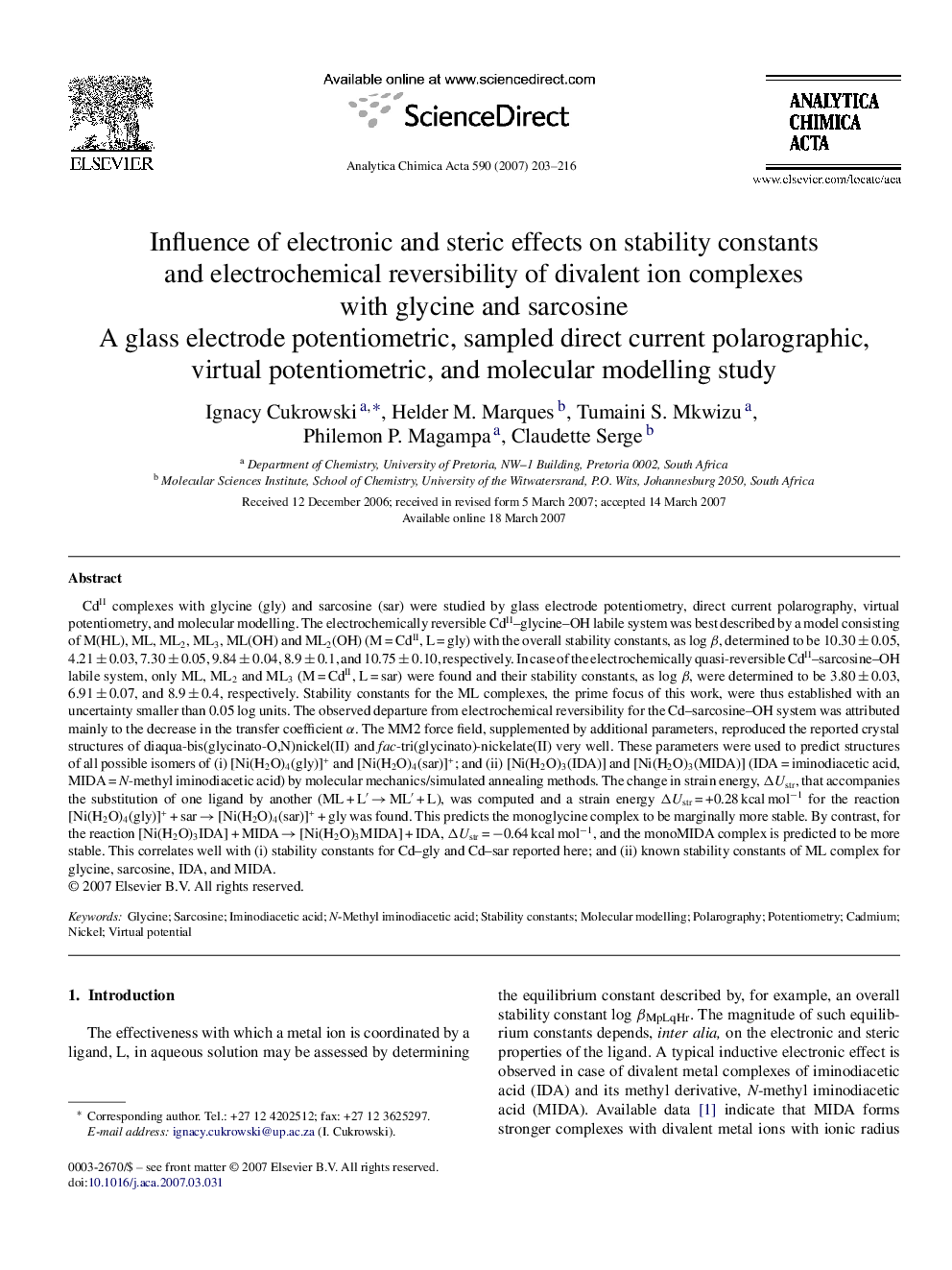| Article ID | Journal | Published Year | Pages | File Type |
|---|---|---|---|---|
| 1171092 | Analytica Chimica Acta | 2007 | 14 Pages |
Abstract
CdII complexes with glycine (gly) and sarcosine (sar) were studied by glass electrode potentiometry, direct current polarography, virtual potentiometry, and molecular modelling. The electrochemically reversible CdII-glycine-OH labile system was best described by a model consisting of M(HL), ML, ML2, ML3, ML(OH) and ML2(OH) (M = CdII, L = gly) with the overall stability constants, as log β, determined to be 10.30 ± 0.05, 4.21 ± 0.03, 7.30 ± 0.05, 9.84 ± 0.04, 8.9 ± 0.1, and 10.75 ± 0.10, respectively. In case of the electrochemically quasi-reversible CdII-sarcosine-OH labile system, only ML, ML2 and ML3 (M = CdII, L = sar) were found and their stability constants, as log β, were determined to be 3.80 ± 0.03, 6.91 ± 0.07, and 8.9 ± 0.4, respectively. Stability constants for the ML complexes, the prime focus of this work, were thus established with an uncertainty smaller than 0.05 log units. The observed departure from electrochemical reversibility for the Cd-sarcosine-OH system was attributed mainly to the decrease in the transfer coefficient α. The MM2 force field, supplemented by additional parameters, reproduced the reported crystal structures of diaqua-bis(glycinato-O,N)nickel(II) and fac-tri(glycinato)-nickelate(II) very well. These parameters were used to predict structures of all possible isomers of (i) [Ni(H2O)4(gly)]+ and [Ni(H2O)4(sar)]+; and (ii) [Ni(H2O)3(IDA)] and [Ni(H2O)3(MIDA)] (IDA = iminodiacetic acid, MIDA = N-methyl iminodiacetic acid) by molecular mechanics/simulated annealing methods. The change in strain energy, ÎUstr, that accompanies the substitution of one ligand by another (ML + Lâ²Â â MLâ²Â + L), was computed and a strain energy ÎUstr = +0.28 kcal molâ1 for the reaction [Ni(H2O)4(gly)]+ + sar â [Ni(H2O)4(sar)]+ + gly was found. This predicts the monoglycine complex to be marginally more stable. By contrast, for the reaction [Ni(H2O)3IDA] + MIDA â [Ni(H2O)3MIDA] + IDA, ÎUstr = â0.64 kcal molâ1, and the monoMIDA complex is predicted to be more stable. This correlates well with (i) stability constants for Cd-gly and Cd-sar reported here; and (ii) known stability constants of ML complex for glycine, sarcosine, IDA, and MIDA.
Keywords
Related Topics
Physical Sciences and Engineering
Chemistry
Analytical Chemistry
Authors
Ignacy Cukrowski, Helder M. Marques, Tumaini S. Mkwizu, Philemon P. Magampa, Claudette Serge,
